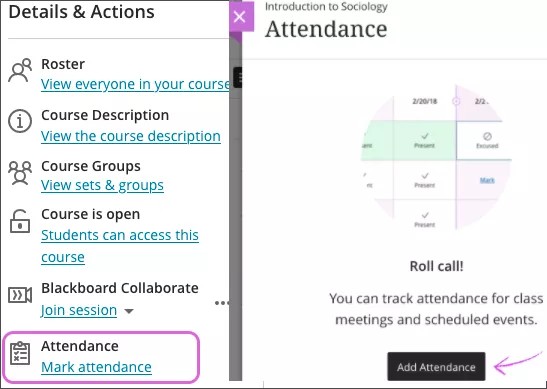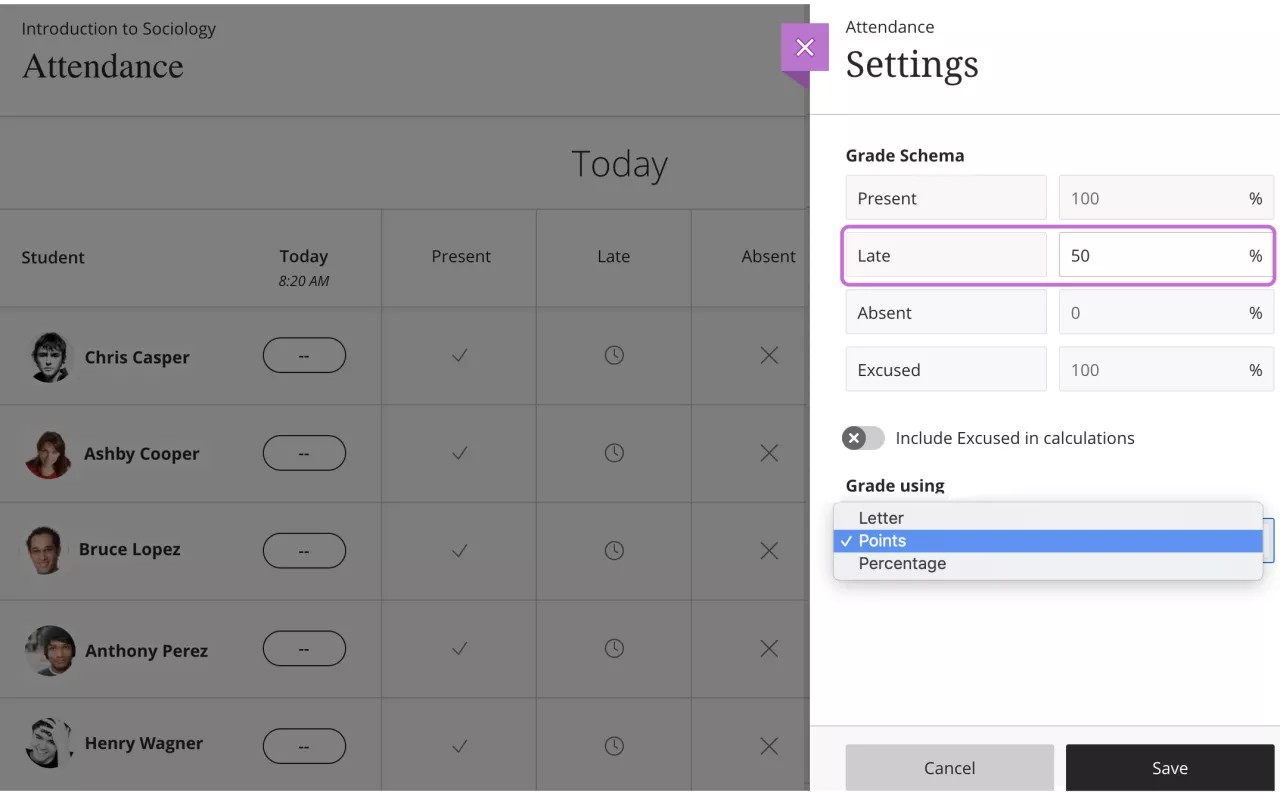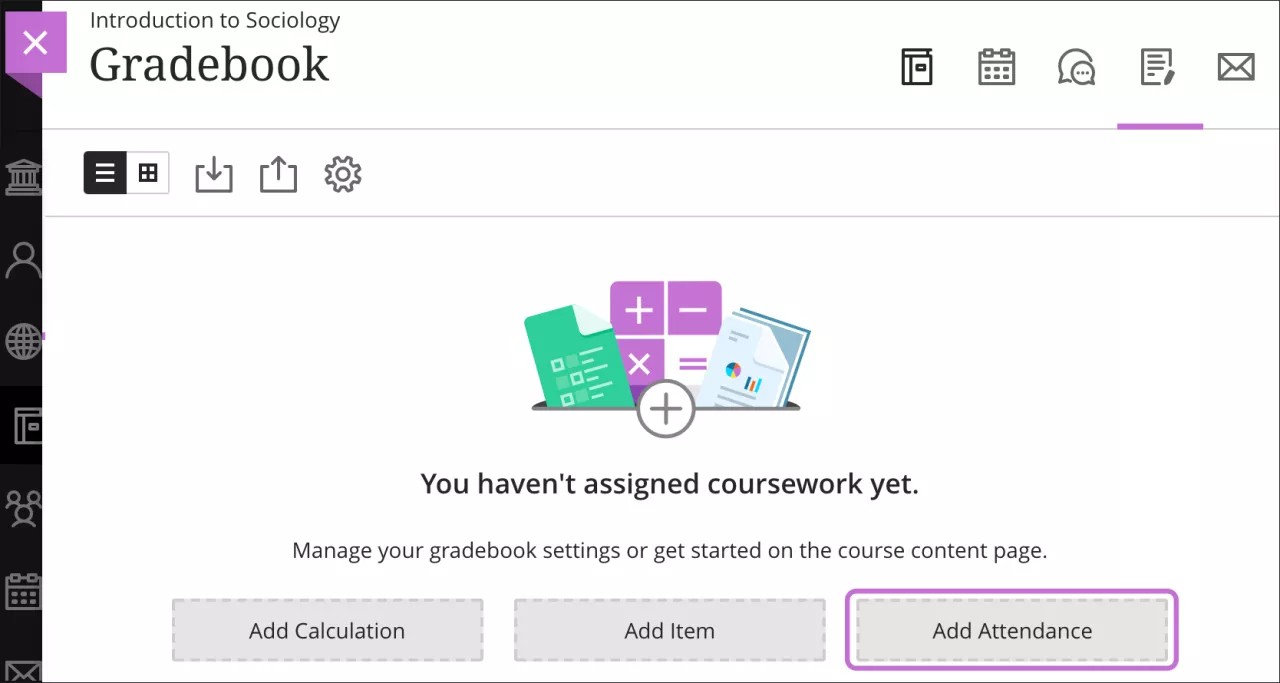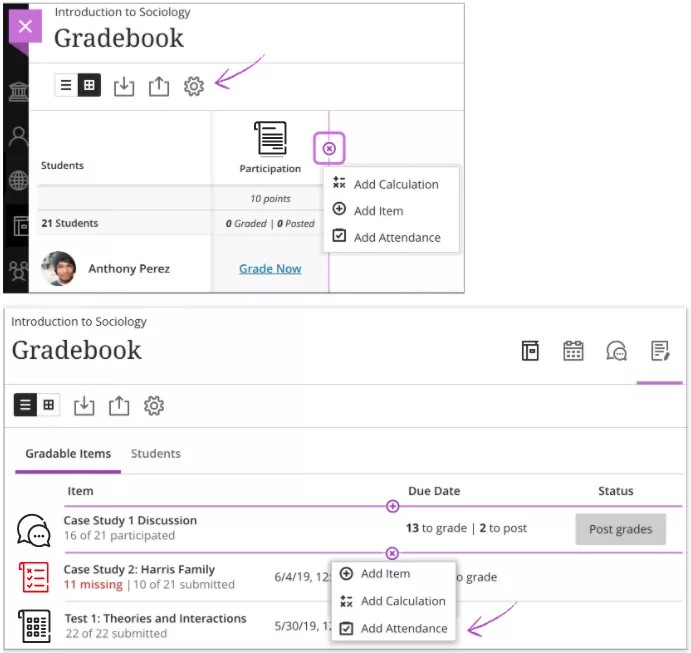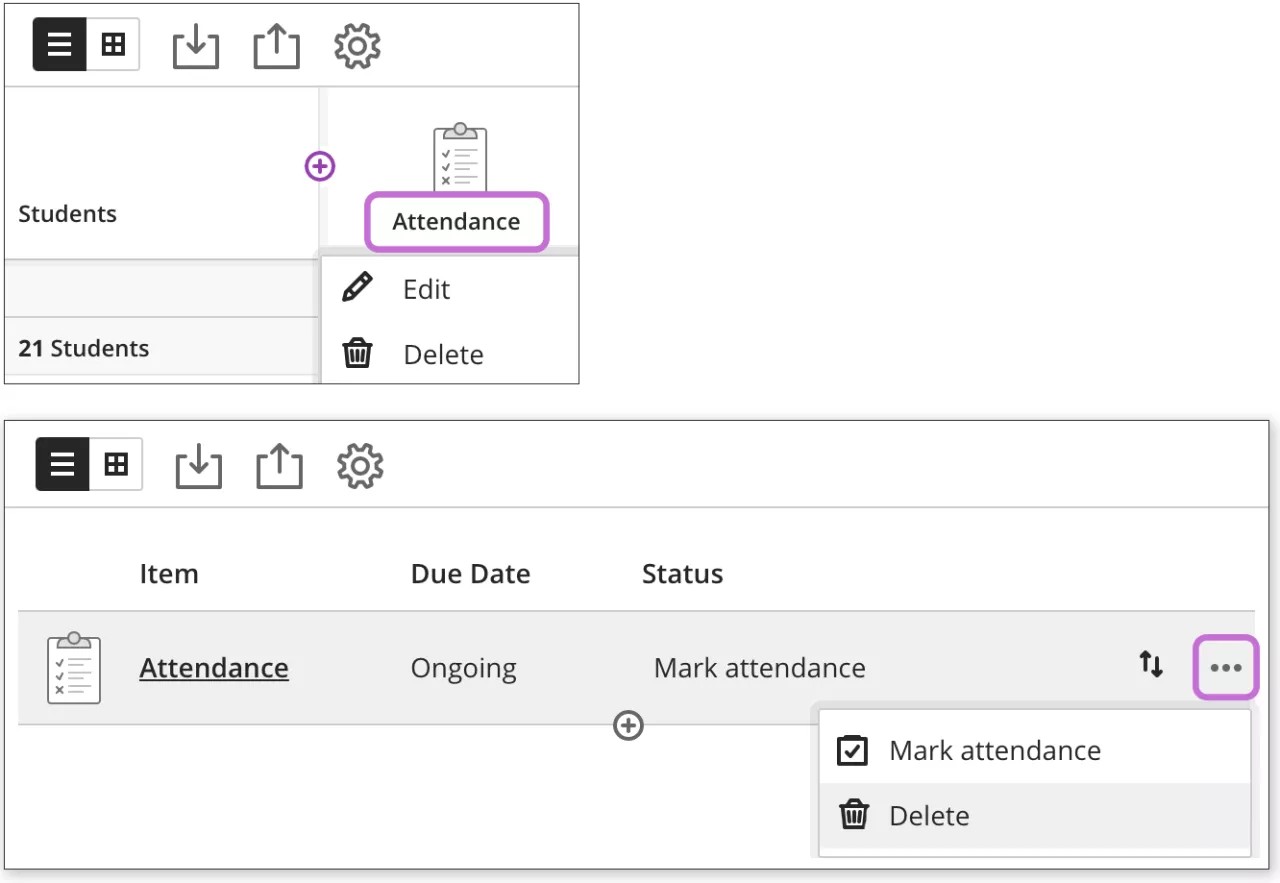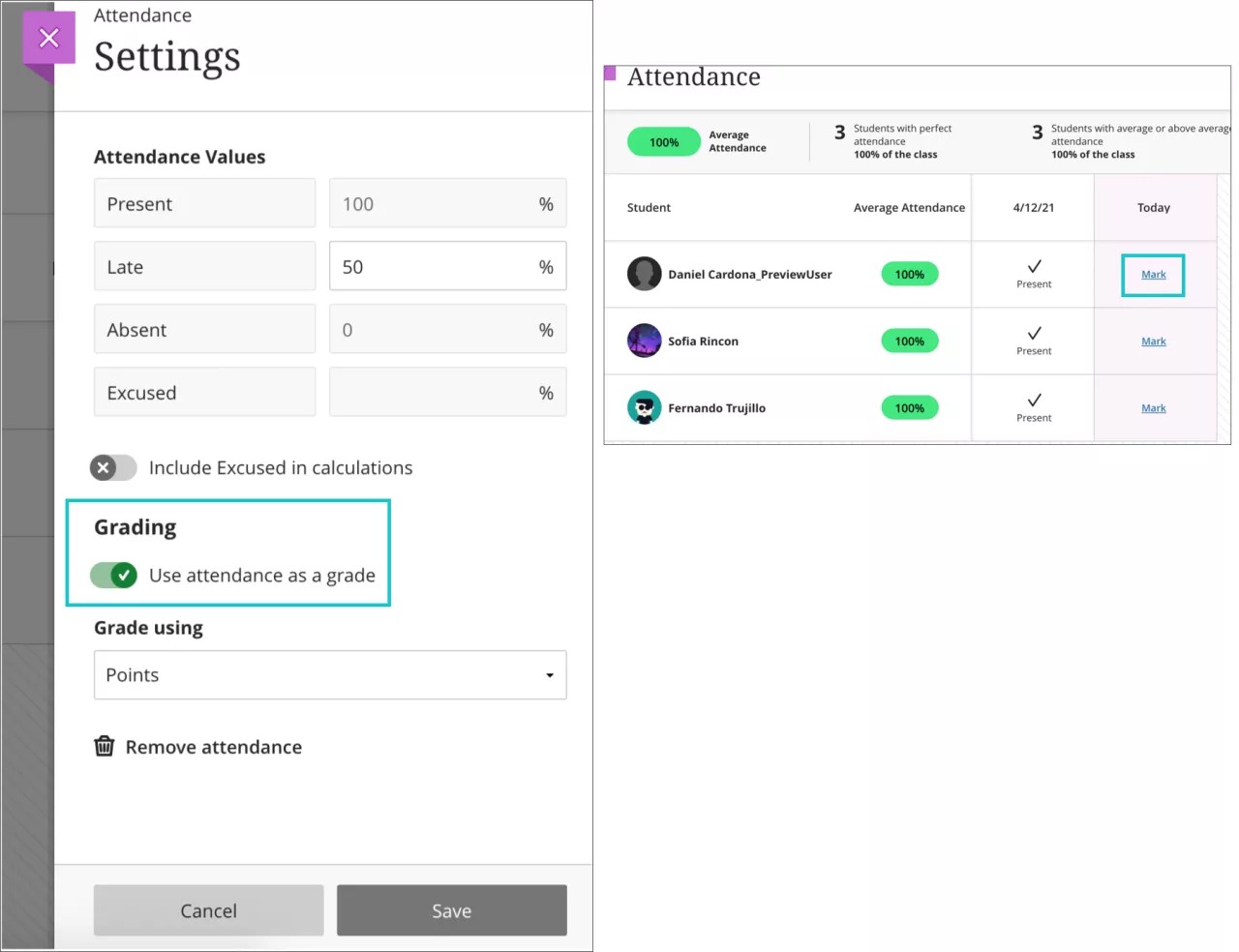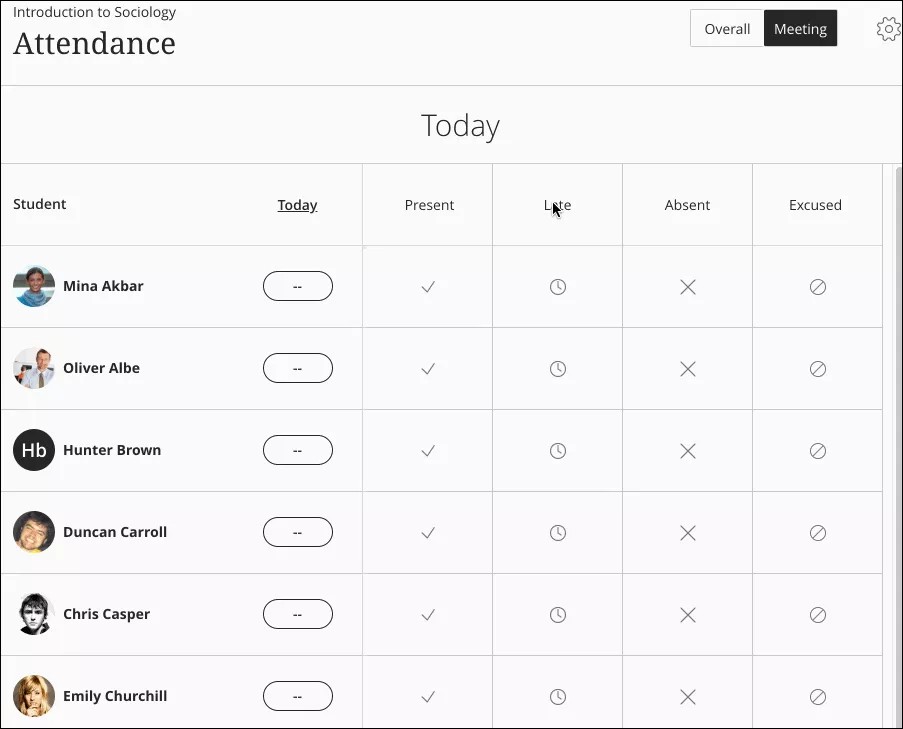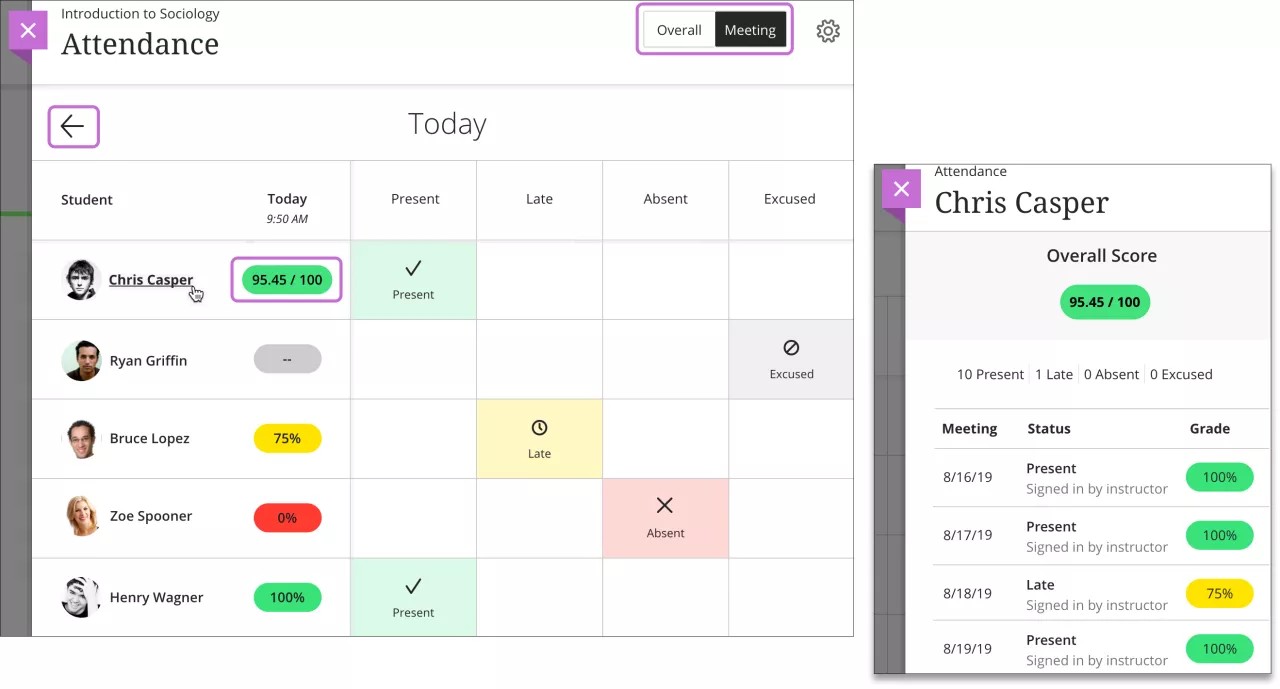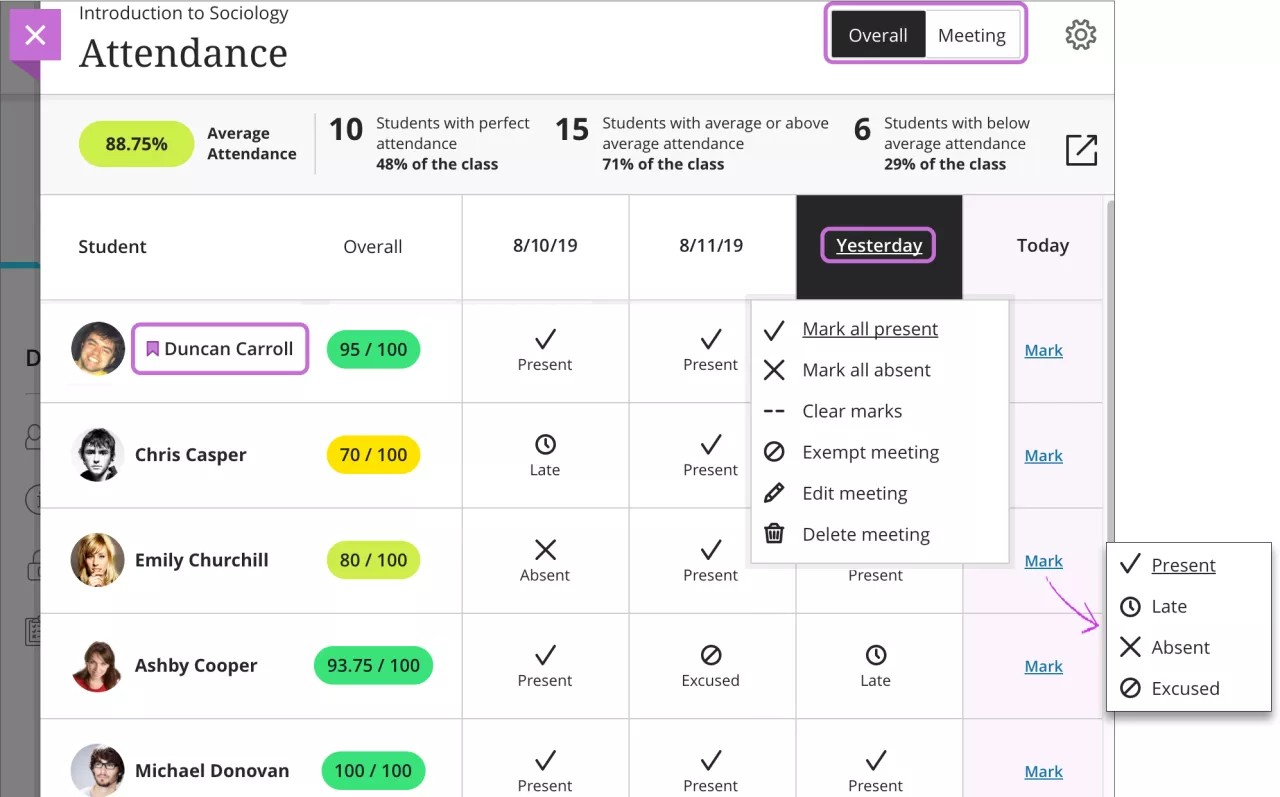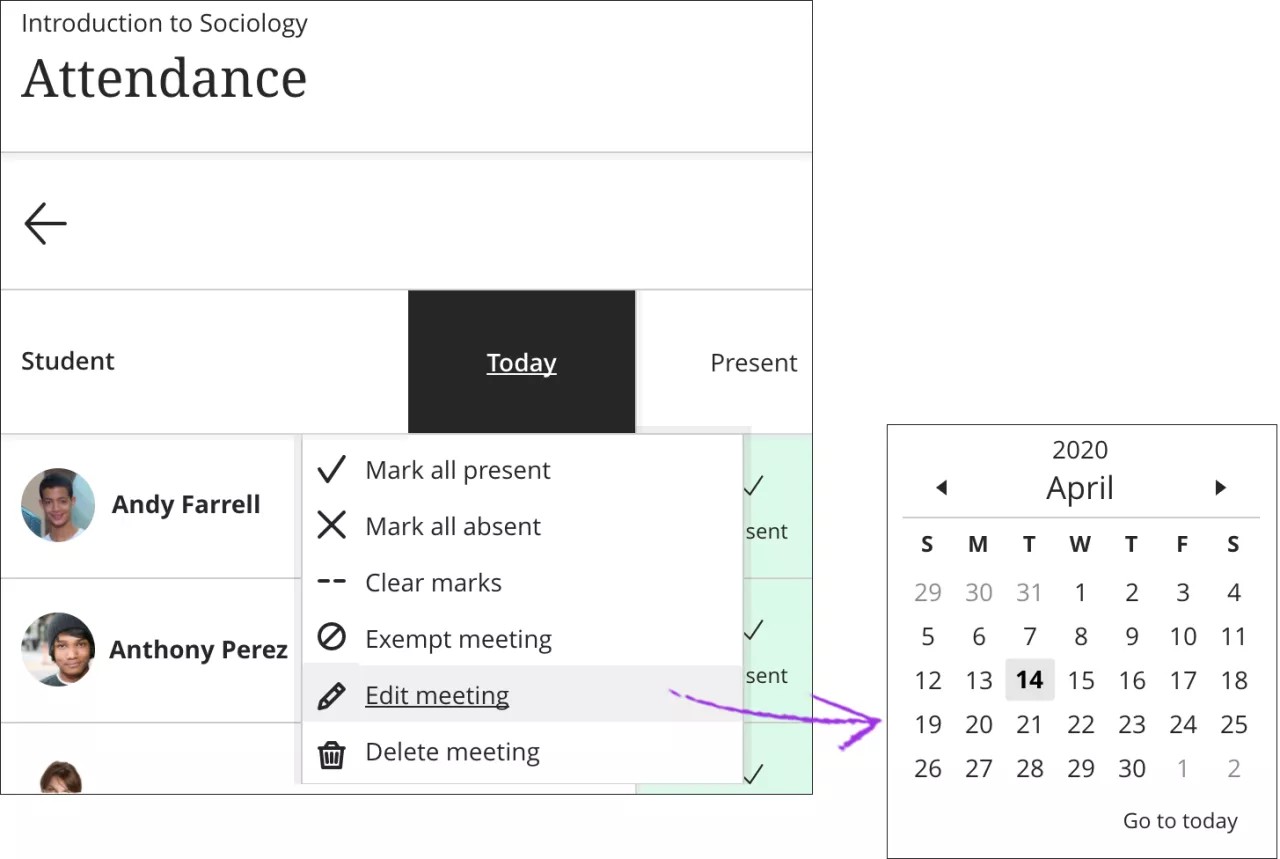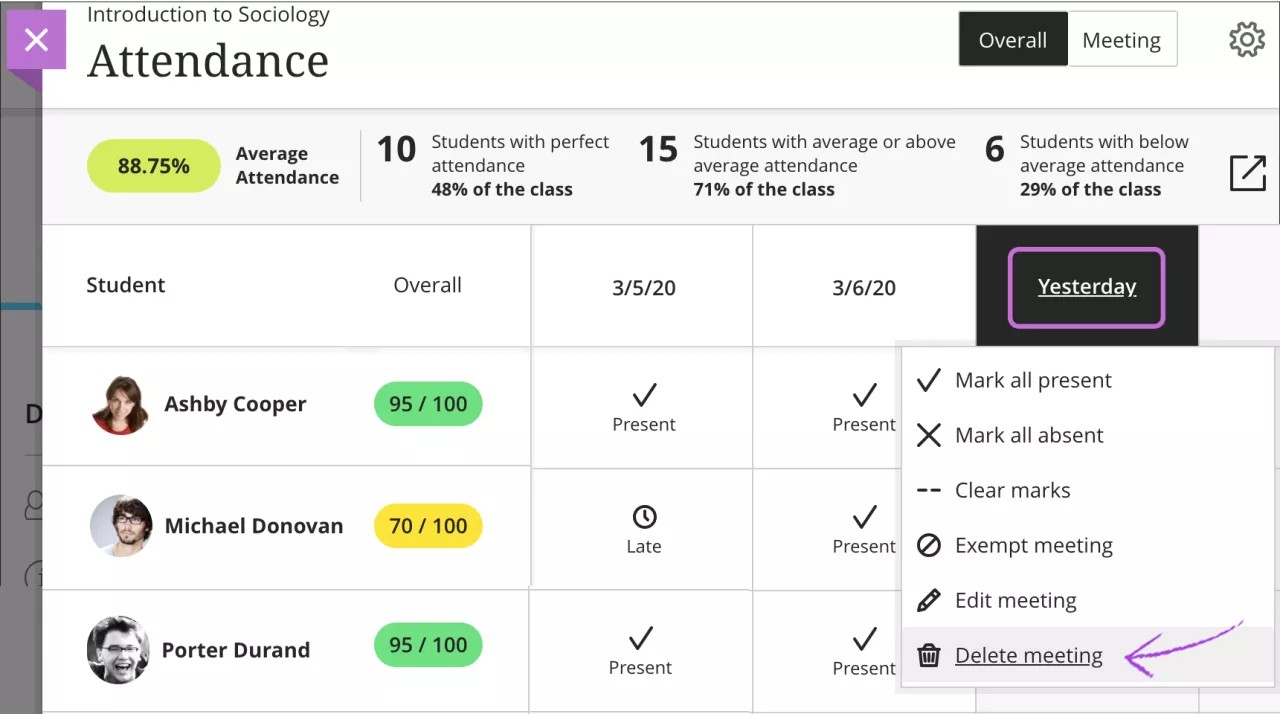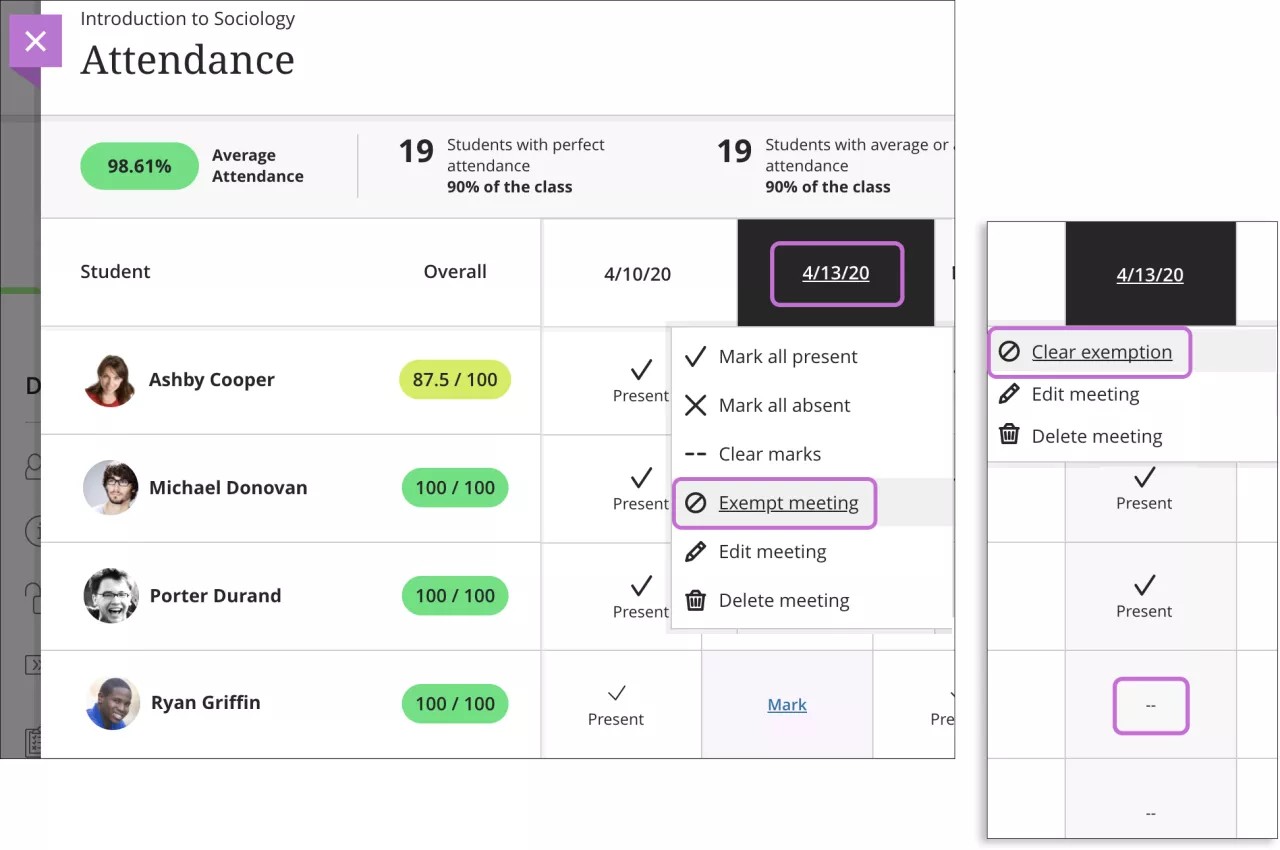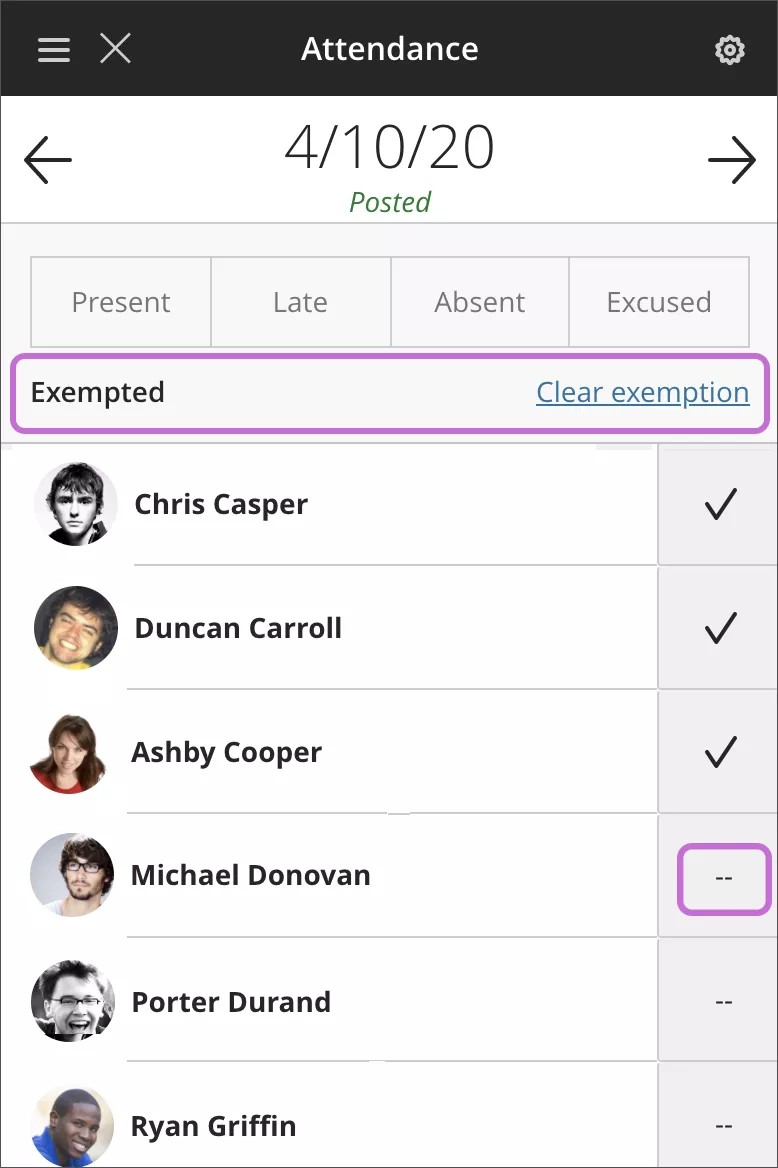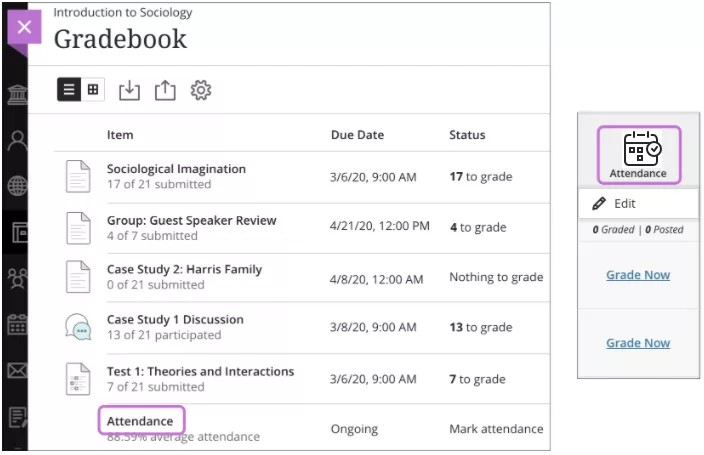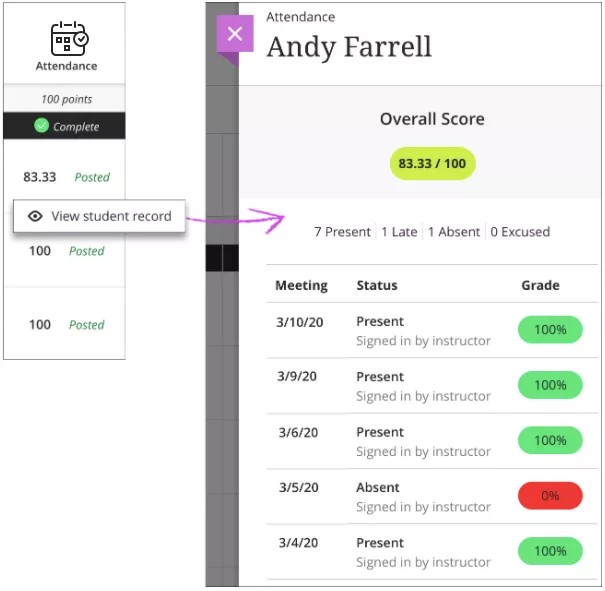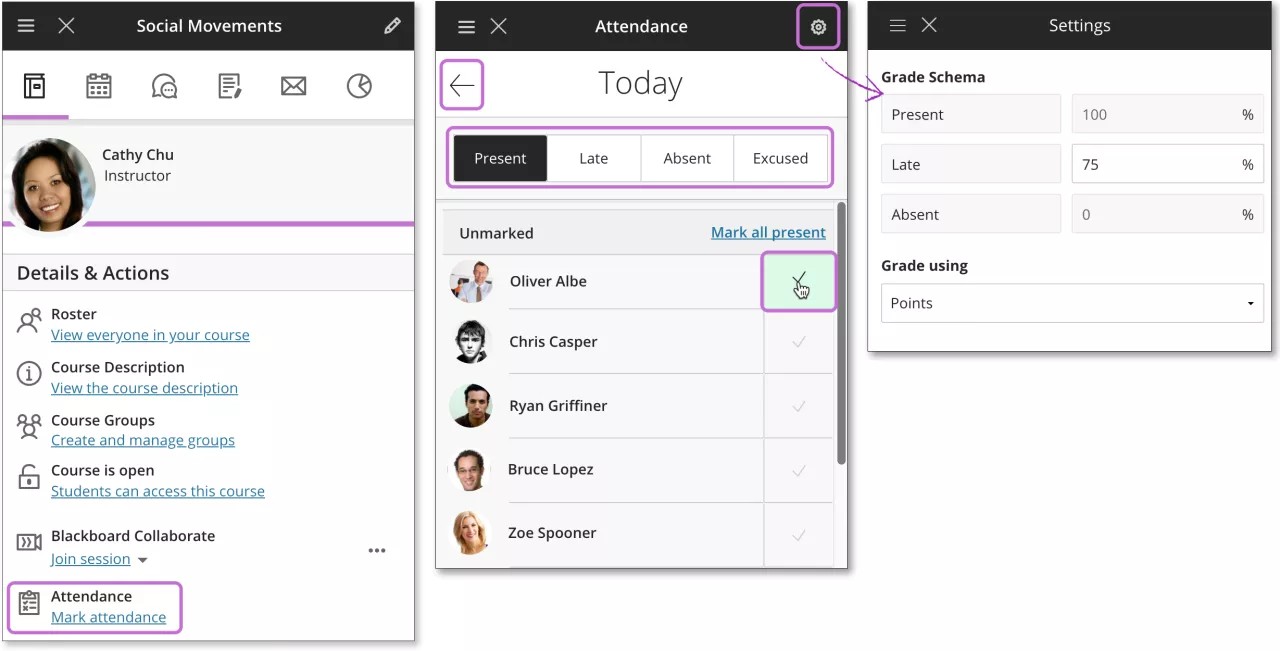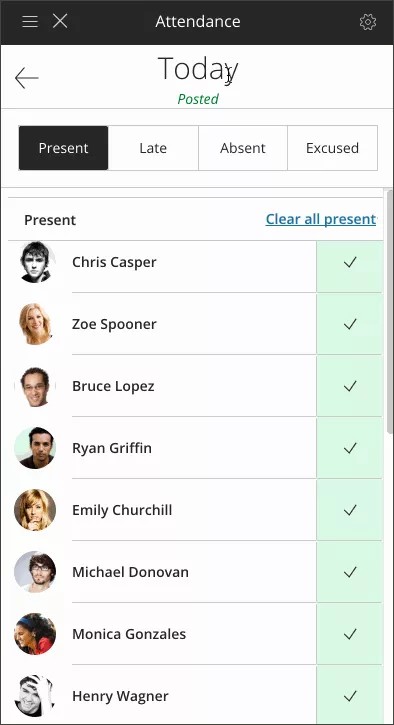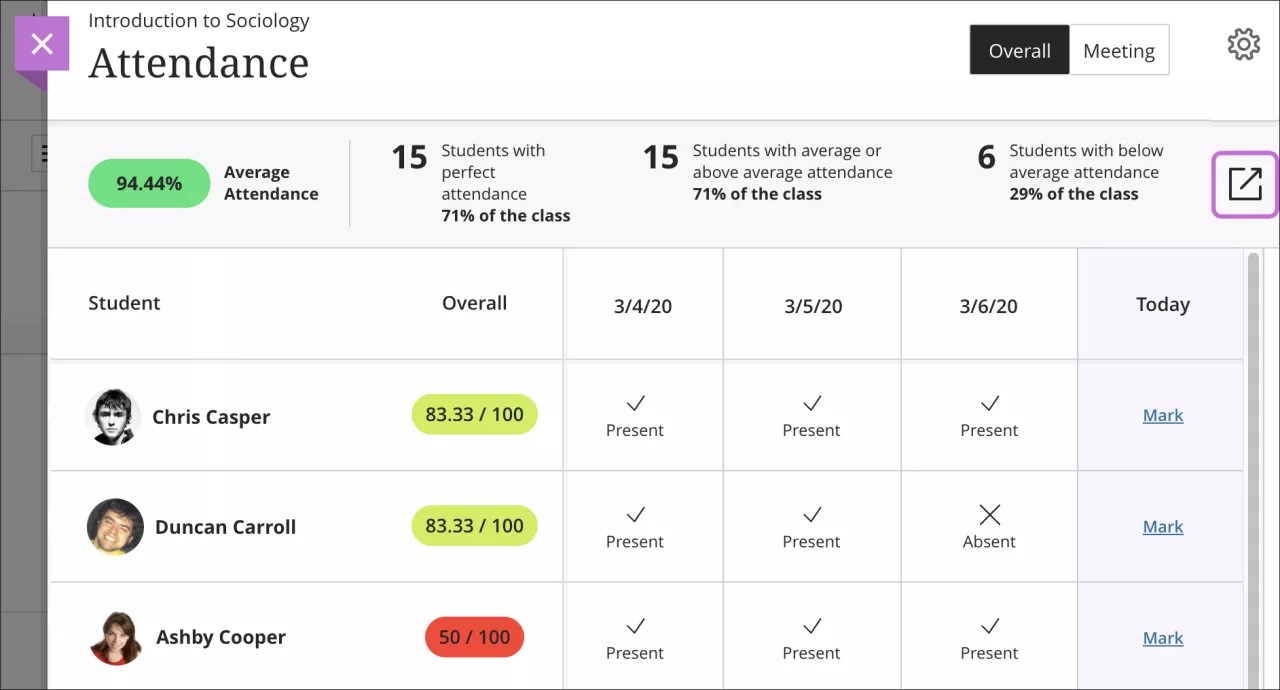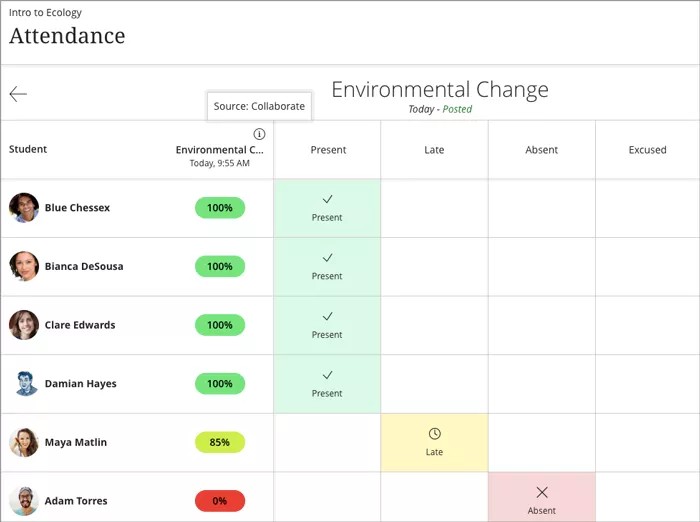Many instructors who teach face-to-face and blended courses use attendance data as part of their students' overall grades. Also, some institutions and programs have attendance policies that require instructors to track the number of class meetings students have missed.
Instructors and institutions also use attendance data in these ways:
- International students who must maintain visas may need to meet attendance requirements.
- Institutions may need to prove “seat time” for federal funding or accreditation.
- Many institutions and instructors use attendance as they focus on student retention.
For each class meeting, you can mark whether a student is present, late, absent, or excused. The attendance records for each student appear in a single column next to other grades. On the Attendance page, profile pictures appear so you can easily identify students.
You can use attendance as part of grade calculations just as you can for an assignment grade column.
Access attendance
On the Course Content page, select Mark attendance in the Details & Actions panel.
When you access the attendance feature for the first time, you decide if you want to add attendance to your gradebook. On the Attendance page, select Add Attendance and the Settings panel opens.
You can change the default settings for the grade display and for Late in the grade schema. You can't change the percentages for Present, Absent, and Excused at this time. Excused counts as Present for scoring purposes. You can choose whether to include Excused in calculations.
Save your settings or close the panel if you don't want to make changes. An attendance column appears in the gradebook.
At any time, you can change the schema in the Settings panel, save, and then refresh the page. You'll see your newly selected schema reflected in the grade pills on the Attendance page in the Overall view.
Add attendance from the gradebook
In a new course where no grades exist in the gradebook, select Add Attendance.
You can add attendance when other grades exist. In Grades view, you can add an attendance column next to an existing column. Select the plus sign to open the menu and select Add Attendance. In Gradable items view, select the plus sign wherever you want to add attendance and select Add Attendance.
After you add attendance, the add option won't appear again.
Delete attendance
In the Ultra gradebook, you can delete attendance if no attendance records exist. In Grades view, select the Attendance column heading to open the menu and select Delete. In Gradable items view, access the attendance row's menu to select Delete.
Gradebook column grading on/off for attendance
You may want or need to track attendance as part of the grading process. However, in some cases, you may not always need it represented in your course's gradebook. You can remove attendance columns from the gradebook without affecting the attendance itself, and you can do so from the attendance settings, using a toggle option that will switch it on or off.
Tour the Attendance page
By default, when you open attendance, you'll see the Meeting view for the current day even if you haven't finished marking a previous meeting. In the Overall view, you can view several meetings and see overall course statistics. You can mark or edit attendance from either view.
Meeting view
In the Meeting view, you can mark each student's attendance. You can also use the menu in a status's heading to mark all students present or absent. Then, you can change individual students' statuses or clear all marks. Your work is saved as you go.
As you mark students' attendance, their attendance grades are posted automatically. If you change students' attendance or clear marks, students see the changes immediately.
Meeting view is the only view that appears on small devices.
Select the date column header to open the menu and perform these actions:
- Clear all student marks for a meeting
- Choose another status for all students
- Exempt the meeting
- Edit the meeting
- Delete the meeting
If you mark all students the same status and want to change to another status, you'll receive an override confirmation.
Statuses
- Present: Set at 100%. You can't change the percentage at this time.
- Late: Default is set at 50%. Adjust the percentage in the Settings panel.
- Absent: Set at 0%. You can't change the percentage at this time.
- Excused: Counts as Present for scoring purposes. You can choose whether to include Excused in calculations.
The Meeting view scores are always percentages regardless of the schema you chose in the Settings panel. Because the Meeting view shows only one status, you'll see the percentage because it's the weight of that one status.
Use the Previous Meeting and Next Meeting arrows to navigate between meetings.
Select student names to view summaries of their overall attendance records. You can see how many class meetings each student has missed. Each student's Overall Score appears with the schema you chose in the Settings panel. This view is read-only.
You'll see an icon next to students with accommodations.
Overall view
In the Overall view, you can mark attendance, view attendance history and class summary statistics, and create new meetings.
As you mark students' attendance, their attendance grades are posted automatically. If you change students' attendance or clear marks, students see the changes immediately.
The most recent meeting you need to mark appears on the right side of the screen. The column is purple until you add marks for all students.
You can use the menu in a column heading to mark all students present or absent. Then, you can change individual students' statuses from their cells as needed. Your work is saved as you go.
If you mark all students the same status and want to change to another status, you'll receive an override confirmation.
Student summary in grade pill
The grade pill for each student displays the overall attendance grade with the schema you chose in the Settings panel, such as A+ instead of 100. Select student names to view summaries of their overall attendance records. You can see how many class meetings each student has missed. This view is read-only. If you change students' attendance or clear marks, the students see the change in their overall grades immediately.
Overall course summary
The Overall view displays course summary statistics about your students' attendance. These statistics are included:
- Course average displayed in the grade pill
- Perfect attendance
- Average or above average attendance: Students with perfect attendance are included
- Below average attendance
If a student has only excused records, no records at all, or is removed from your course, the student's attendance isn't included in the course summary statistics. The number of students listed for each statistic might not equal your total student count.
If every student has an attendance record, the average/above average and below average statistics add up to all students.
Unavailable students' information appears read-only and their previous attendance grades won't be included in the course summary statistics.
Watch a video about marking attendance
The following narrated video provides a visual and auditory representation of some of the information included on this page. For a detailed description of what is portrayed in the video, open the video on YouTube, navigate to More actions, and select Open transcript.
Video: Mark Attendance shows you how to mark attendance in Blackboard Learn.
Edit a meeting
Select the date column header to open the menu and select Edit meeting. You can choose a new date from the pop-up calendar. If you change the date of a meeting or select Go to Today, all meetings are chronologically sorted when you close and open the Attendance page.
You can choose a meeting date in the future. If you have one or more meetings in the future, the Meeting view still opens to the most recent Today meeting.
Add or delete a meeting
In the Overall view, you can add a meeting if your class met outside of the established course schedule. You can also delete a meeting if you canceled class.
Add a meeting
In the Overall view, you can add more than one meeting for attendance on a day. For example, if your class met for a field trip after your regularly scheduled class, you can add a meeting and mark who was present. Select the plus icon next to an existing meeting's date to add a new meeting.
Delete a meeting
You can delete a meeting in either view, but at least one meeting must remain. You can't have an empty Attendance page. If you have only one meeting and you delete it, a new Today meeting replaces it.
Students' overall attendance grades update to not include the deleted meeting.
In the Meeting view, select the date column header to open the menu and select Delete meeting.
In the Overall view, select a date column header to open the menu and select Delete meeting.
Exempt a meeting
In the Meeting or Overall view, you can exempt a meeting that no longer requires an attendance grade. Students' overall attendance grades update to not include the exempted meeting, even if you've marked some or all student cells. You can also clear the exemption in both views.
When you exempt a meeting, that meeting's column header menu no longer contains options to mark all students present or absent. Also, the menu option Exempt meeting changes to Clear exemption.
Exempt meeting columns appear gray and all grid cell menus are disabled. A null or empty value (--) appears for all students without a mark. If you marked students with a status, those statuses remain but are read-only and you can't change them.
On smaller devices, you can only view attendance in the Meeting view. When you exempt a meeting, the status options are disabled until you clear the exemption.
View attendance in the gradebook
You can access attendance from the Gradable items or Grades view in the gradebook. The attendance column is added automatically to the Attendance category.
You can use attendance in calculations and as part of the overall grade.
In Gradable items view, select Attendance to open the most recent Meeting view to mark attendance. In Grades view, select the Attendance column header to open the menu and select Edit.
In the Grades view, you can't edit attendance cells. Select a student's attendance cell and select View student record to view a summary of the student's overall attendance record. You can see how many class meetings the student has missed. The student's Overall Score appears with the schema you chose in the Settings panel. This view is read-only.
Mobile and tablet views
In your face-to-face classroom, you can use your mobile phone or tablet to mark attendance while you stand in front of your class. You have access to a compact view of attendance that displays one meeting at a time, complete with your students’ profile pictures. No need to make notes for later or take attendance on your computer.
At the top of the screen, you can select a status and mark all students in one action. Your work is saved as you go. Or, you can individually mark some students one status and move to the next status. Students are grouped by the statuses you assigned. Unmarked students move to the top of the list. If any students are unavailable, they appear in a separate section.
As you mark students' attendance, their attendance grades are posted automatically. If you change students' attendance or clear marks, students see the changes immediately.
Use the Previous Meeting and Next Meeting arrows to navigate between meetings.
Export attendance data
In the Overall view, select the Export icon to download a CSV file with your students' attendance records. The download begins immediately without a confirmation.
Attendance and course copy, archive/restore, and export/import
Attendance data isn't included in a course export or when you copy a course into a new or existing course. The attendance option is removed from the copy and export options.
Attendance data is included in an archive/restore and in an exact course copy.
Export/import creates an attendance column that you can't delete, but no attendance data is added.
Specific scenarios and the results
- If you copy a course with attendance data into a new course or an existing course with no attendance data, the source course's attendance data is not copied. One attendance grade column without data is added that you can delete.
- If you copy a course with attendance data into an existing course with attendance data, two attendance columns exist. You can delete the extra column.
- If you make an exact copy of a course with attendance data, the new course has one attendance column with all the data from the source course.
- If you export a course with attendance data and import it into an existing course with no attendance data, the existing course has no attendance data. However, you can't delete the attendance column.
- If you export a course with attendance data and import it into an existing course with attendance data, the existing course has two attendance columns. You can't delete the extra column. Both columns open to show the same data. If you delete data from one column, you remove it from the other.
- Attendance data is included in course archives. When you archive your course, you create a frozen snapshot or permanent record of your course. An archive includes all the content, course statistics, users, and course interactions, such as discussions, attendance, and grades. If you archive and restore a course, the new course has one attendance column with all the existing data.
Delete copied course attendance data
When you prepare a course for an upcoming term, you may copy all content, including grade columns, from the last term’s course. You can delete attendance columns added during a course copy.
You can also delete the attendance column associated correctly with your course if you remove all students' attendance records first.
In your Ultra gradebook, open the menu for the "extra" attendance column and select Delete. You can delete the column in Gradable view or Grades view.
Collaborate attendance reporting
Let Collaborate take attendance for you. If you use Collaborate from your Blackboard Learn course, you can choose to have Collaborate send student attendance to your Blackboard Learn course Attendance page.
Students must join the session through the Collaborate tool in their course. Anybody who joins from a guest link won't have that session count towards their attendance.
Attendance reporting is off by default. You must turn attendance reporting on for each session you want to track attendance in. Attendance reporting is only available in sessions with an end date and time.
More on turning on attendance reporting in your Collaborate session
Based on the criteria you set, Collaborate tracks if a student is present, late, or absent from a session. Collaborate then sends that information directly to the Attendance page in your Blackboard Learn course.
Attendance from the Collaborate session is counted in each student's average attendance in the course, which can also be used in calculating student grades.
You’ll notice these things on the Attendance page:
- Collaborate attendance information appears in chronological order and shows the name, date and time of the session. You can change the date of the meeting but not the name or time.
- The source information icon appears above the session name. If you move your pointer over it, you see the source of the information is Collaborate.
You can edit, delete, and exempt Collaborate attendance information.
Meeting vs. Overall view
Meeting view: The source information icon appears above the session name.
Overall view: The source information icon appears above each session name.
